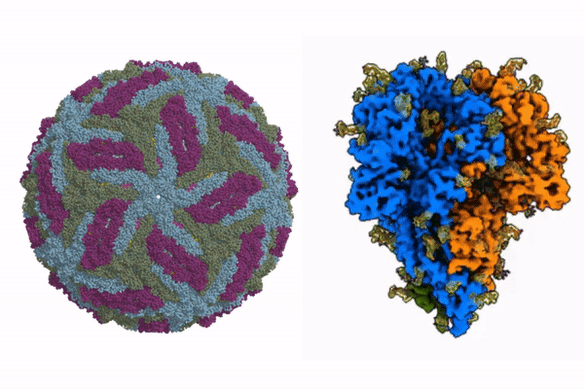
The fact the protein is so plant-like and unusual offers an extra advantage, Ellisdon said.
“Because there are no other proteins very similar to LYCHOS in humans, that makes it a really nice drug target. If there are lots of similar proteins in the body, it can be difficult to target them specifically, and you get off-target effects with drugs.”

Leaps forward in cryogenic electron microscopy have led to high-resolution imaging of micropscopic structures, such as Zika virus (left) and the COVID-19 spike (right).Credit: Wikimedia/K. Zhang et al., Quarterly Reviews of Biophysics Discovery, 2020
Decades of research has already gone into auxin transporters in plants, giving scientists a head start on inhibiting the LYCHOS protein in humans.
“We want to understand its role in some of the diseases where cell growth goes wrong,” Ellisdon said. “I think we will be able to inhibit this protein which will hopefully slow down growth.”
The other part of LYCHOS is made up of a G protein-coupled receptor (GPCR), a well-understood structure that’s a common drug target because it exists on cell membranes, so it’s easy to reach with medicine.
Loading
“A lot of the really well-known therapeutics like beta blockers for cardiovascular disease, salbutamol for asthma, they’re all targeting G protein-coupled receptors,” Halls said.
The scientists and their colleagues used cutting-edge cryo-electron microscopy to snapshot millions of low-resolution images of LYCHOS, which they combined into a high-resolution, 3D model.
The microscopy process saw lab-grown samples of the protein taken to temperatures lower than minus 160 degrees, which stops atoms vibrating and protects the sample from getting scorched by the microscope’s electron beam.
“Cryo-EM is really revolutionising our ability to capture protein structures and then target those therapeutically,” Ellisdon said.
The Examine newsletter explains and analyses science with a rigorous focus on the evidence. Sign up to get it each week.



























